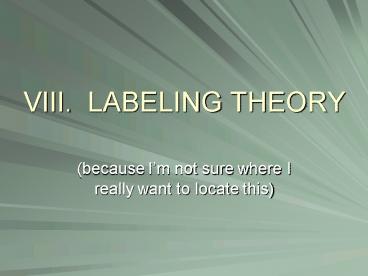VIII. LABELING THEORY - PowerPoint PPT Presentation
1 / 9
Title:
VIII. LABELING THEORY
Description:
b. as we have the ability to live up to expectations, ... 'The Outsiders: Studies in the. Sociology of Deviance' a. emphasized that the role of the. labeler ... – PowerPoint PPT presentation
Number of Views:375
Avg rating:3.0/5.0
Title: VIII. LABELING THEORY
1
VIII. LABELING THEORY
- (because Im not sure where I really want to
locate this)
2
A. Introduction
- 1. basic premise
- a. we are what people think of us
- b. as we have the ability to live up
to expectations, we also have - the ability to live down to them
- c. modeling / learning
- 2. legacy of the Symbolic Interactionist
perspective - a. human interaction is a form of
social control - b. Charles Horton Cooley (1902)
looking glass self - gt we all see ourselves through the
eyes of others - c. W I Thomas (1923) definition of the
situation
3
- 3. functionalist contribution
- a. Robert K Merton (!949)
self-fulfilling prophecy - 1) social structures are organized
in a hierarchy that - establishes social status on
certain individuals - 2) we act as we do based on the
expectations of others and - ourselves
- b. Frank Tannenbaum (1937)
dramatization of evil / - social tagging
- 1) first to identify a labeling
perspective - 2) crime / deviance reflects an individuals
acceptance by / of - a criminal / deviant group
4
4. Garfinkels (1956) Successful Degradation
Ceremonies (A Moral Indignation) model
Mentally Ill
Treatment
Physically Ill
NORMAL BEHAVIOR
5
B. The Theory
- 1. Edwin Lemert primary and secondary
deviance (1967) - a. primary deviance the initial
behavior that causes recognition - gt the behavior that is
identified as deviant that gains the - attention of authorities
- b. secondary deviance, individual
incorporation of - societys response (label)
- c. Goffman (Stigma, 1963) calls this
spoiled - identities, negative self-images
(1922-1982) - d. premise
- 1) individual behaves
aberrantly - 2) behavior is noticed (an
arrest) by authorities who then - respond
6
- 3) label is attached
- gt Goffmans deviancy
amplification - 4) upon being labeled,
individual will act in the manner - consistent with his / her
expectations of that label - e. comments
- gt is it the label or
the response - 2. social order
- a. law is the expression of moral
certitude and control - b. crime is a status, an achievement,
an abstraction - gt criminal is an ascribed
social construction of which there - are masters, journeyers, and
apprentices
7
- 3. affect on criminal justice
- a. Critics the system creates the
offenders it wants - b. Supporters labeling deters
- c. Practice, what to do knowing what we
know? - 1) radical non-intervention (Schur,
1973) - a) dont ask / dont tell
- b) eventually, we all grow up
- 2) diversion programs
- 3) VOMP
8
-
4. Howard Becker (1928 - ) -
The Outsiders Studies in the
-
Sociology of Deviance -
a. emphasized that the role of the -
labeler -
- gt the labelee must agree that the
labeler has credibility - b. (controversially) human behavior is
mostly neutral, the social - order is responsible for creating
significance beyond the act
9
C. Criticisms
- 1. What about primary deviance?
- gt does not address original sin
- 2. Does not address those who eschew the
label - gt those with significant self-esteem /
self concepts - 3. Ecological fallacy































